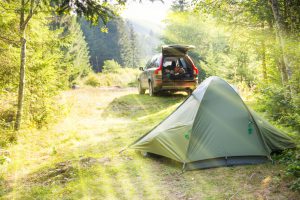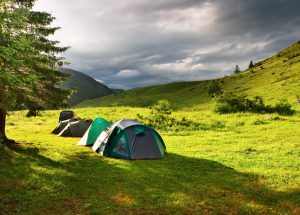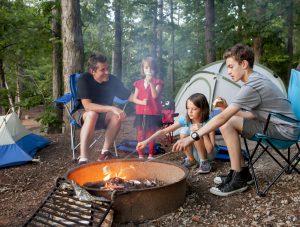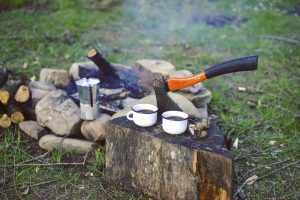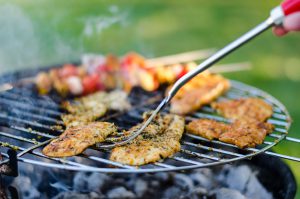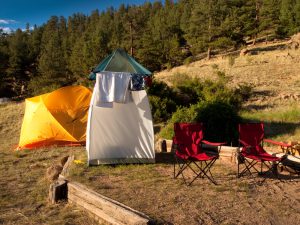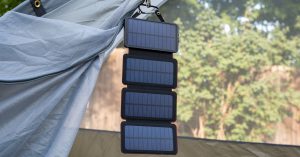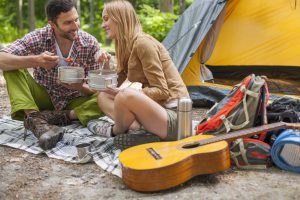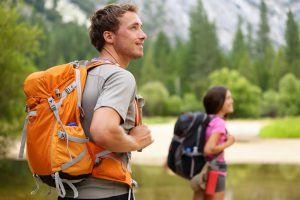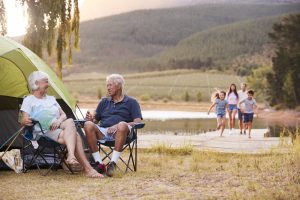Complete Car Camping Gear Guide
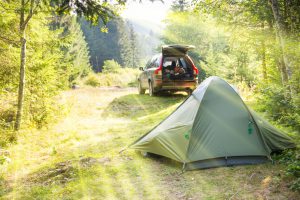
If you’ve never been camping, or have limited camping experience then car camping is a great way to get started. The typical definition of car camping is when you camp near your car. Having your car nearby and extra supplies only a short distance makes things a lot easier compared to a long hike into a campsite. And worst-case scenario you’ll have a dry and warm place to retreat to if needed.
To help you out, we’re going to present you with a list and discussion of the most important items to bring along for your next (or first) car camping trip:
Shelter and Sleeping
Easily the most important camping shelter item to have is a tent (assuming you won’t be using an RV of some sort), when choosing a tent for camping, the two most important factors to look for are a tent that can accommodate everybody in your group and that is high quality enough to keep you dry in bad weather.
Keep in mind, you and everyone else in your group may have to hang out inside the tent when the weather gets bad outside, so there needs to be enough room for each person. If you have a rather large group, you can always buy more than one tent, but you still need to make sure that there’s enough space for each person to stretch out and be comfortable.
A three-season tent will be the best kind of tent to buy. Such tents are designed to be used for the spring, summer, and fall months. These kinds of tents will consist of the tent body, rainfly, and then mesh panels to provide the tent with proper ventilation, preventing the interior room becoming damp.
Each individual is also going to need a good sleeping bag. Sleeping bags are manufactured to handle different temperature ratings, so you need to find a bag that can handle the lowest ratings you expect to encounter on your trip (keep in mind that even during the summer, it can still get very cold at night out in the mountains). While you can also bring blankets along to help keep you warm,
With sleeping bags, will also have to decide between getting a bag with synthetic or down insulation. Synthetic insulation bags are designed to keep you insulated even when it’s raining and are also bulkier on average. Down insulation sleeping bags are designed to be warmer and lighter but are also more expensive.
Finally, also consider investing in a sleeping mattress, to help make your nights more comfortable so you can get good sleep. The plusher the mattress is, the better. Most outdoor sleeping mattresses will be between one to three inches thick, so you should aim for one that’s two inches thick at the minimum.
Shelter and sleeping checklist:
- Sleeping bags
- Sleeping pads/air-mattress
- Pillows or just pillowcases (make a pillow with clothes)
- Tent, with hammer, small broom
- Easy Up shelter for shade/rain
- Tarps for under tent or other rain issues
- Firewood, fire starters and kindling (paper)
Food and Cooking
Before embarking on a camping trip, you need to clearly establish who in your group is going to be doing the cooking and what meals they will be making. The best kinds of meals to make while camping are meals that are relatively quick and easy to make and can feed a lot of people. Chili, soup, cheeseburgers, chicken fried rice, and soft tacos are examples of meals that fit this criteria perfectly, as the ingredients can be easily kept in coolers and the meals can be prepared with not much time or effort.
It’s also important that you bring all of the necessary cooking equipment to make each of those meals as well. For car camping, you’ll need to invest in a dual burner propane stove that can hold several pots and pans at once. Backpacking-style canister stoves won’t be sufficient.
You’re also going to need plenty of utensils (forks, knives, spoons, etc.), plates and bowls, mugs and cups, and a cooler that can fit all of the food and beverages that require refrigeration. It is absolutely important that you plan each individual meal ahead of time, and then make sure that you buy all of the ingredients and have room for all of the ingredients as well.
As far as water is concerned, the golden rule to follow is to set aside at least one gallon per person per day, as this is the amount of water the average adult needs daily in order to be hydrated and provide water to wash with.
Don’t forget that you need to clean up after each meal so bring cleaning supplies for your dishes.
Food and cooking checklist:
- Food, snacks, nuts, chips, bananas, s’mores
- Snack bars and water for hikes
- Cooler(s) & Ice
- Alcohol, mixers, bag of clean ice, cups
- Nonalcoholic drinks, juice, sodas for kids, etc
- Coffee, sugar, etc and coffee cups
- Salt & Pepper, other spices, other condiments
- Water – 1 gallon per person, per day
- Reusable water bottles to refill
- Paper towels, paper plates, solo cups, bowls, plastic eating utensils
- Wine bottle opener, Wine cups (if wine)
- Tinfoil (heavy-duty)
- Car Camping: Large Tupperware to hold kitchen stuff
- Cooking utensils, pots & pans, tinfoil trays
- S’mores sticks
- Glove for hot pans
- Can opener
- Cutting board (for food prep), if needed
- Covered pot to boil water
- Gas stove, if needed. Extra gas
- Small gas burner (Jetboil) for water/coffee
IMPORTANT: after each meal, all food should be put away to avoid animals coming into the campsite. While sleeping all food should be placed in cars. This includes coolers with food or drinks in them. There should be no food, snacks or personal hygiene items in your tent or campsite overnight.
Cleaning and Personal Hygiene
Cleaning and personal hygiene are not things that should be neglected while you are camping. The standard personal hygiene items of toothbrushes and toothpaste, soap and shampoo, deodorant, hand sanitizer, towels, and so on will need to be brought along.
The campground you visit may have showers present on-site, or if you’re just going to be camping out in a remote area in the woods without any real amenities you’re going to have to do your bathing either in a natural water source or with a camping shower (which you can fill up with water and then leave out under the sun all day to heat up).
Also, does the campground you are visiting have bathrooms or toilets in the area? If not, then you’re going to bring a folding camping toilet seat with you and then a shovel so you can dig a hole to dispose of waste. Always build the latrine area a minimum of two hundred yards away from camp and any water source.
Cleaning and personal hygiene checklist:
- Wet wipes
- Paper towels, Toilet paper, small Kleenex packs
- Small towel
- Large towel for a wet dog in tent
- Small broom and dustpan (clean out tent)
- Dish soap, cleaning brush, bucket, if needed – how going to clean dishes?
- Hygiene – toothbrush, etc. (don’t forget kids)
- Camping shower (if applicable)
- Folding camping toilet seat (if applicable)
Power
Yes, you’re camping and therefore likely want to get away from a lot of the electronics, luxuries, and amenities that we use every day in our day-to-day lives. But there are still some items that require electricity that you will need to bring with you on your camping trip.
For example, headlamps, flashlights, and lanterns will be very useful items to bring to help you see in darkness (along with batteries) You would also be wise to bring along things such as solar chargers to keep your phones charged (even if you’re not going to be using your phones, you are still going to want them charged in case if you need to contact anybody in an emergency).
Power items checklist:
- Cell phone “car” charger cords
- Pocket jumper (charged) to jump-start cars
- Solar chargers with all cords needed
- 1 Flashlight per person, check batteries
- Battery packs charged
- Flashlight lantern, hanging flashlight, small keychain flashlights for kids
- Music, small speaker
Safety
Your top priority in any camping trip, besides having fun, should be safety. Accidents can and do happen, and when you’re at a campground or out in the woods you’re going to likely be miles and miles away from the nearest professional medical help. Also keep in mind that even the smallest of cuts or knee scrapes deserves medical attention because if it’s left untreated a bad infection can set in.
All this is why you must absolutely bring a first aid kit with you on your camping trip. The best kind of medical kit to bring will be a custom one that you make yourself, because this way, you are familiar with all of its contents and know where they are. Bandages, gauze pads, antibiotic ointment, alcohol wipe pads, a week’s supply of prescription meds, tourniquets, scissors and tweezers, and emergency space blankets are the bare minimum that your kit should have.
Safety items checklist:
- Print out a map of the area
- Bear spray
- Life Jackets (if camping around a lake)
- Whistles, give to kids & test
- First Aid kit (large for the car and small for hikes)
- Compass
- Tell someone where you are camping
Comfort Items
You’re going to be spending a lot of your camping trip being active and having fun, doing things such as hiking, biking, fishing, playing games, etc.
But you’re also going to feel tired at times as well, and for the hours that you want to spend relaxing, you’ll need to be prepared. Foldable camping chairs will be a must have for any camping trip, as they are easy to transport and surprisingly comfortable to sit in. A hammock can also be a fun (and comfortable) thing to set up in the campsite as well.
Also, don’t forget to bring extra changes of clothes for different types of weather, entertainment items for if it rains, sunscreen and bug spray for protection from the sun and mosquitoes, and so on. Even if the forecast is for no rain, plan on rain!
Comfort items checklist:
- Foldable chairs
- Winter caps for sleeping
- Baseball hats (avoid ticks in hair)
- Rain jackets
- Sunscreen
- Bug spray
- Hammock
- Sandals, wet shoes
- Entertainment, cards, games, charged ipads for kids
- Blanket
- Hand warmers
- Long socks, for hiking through tall grass
Tools
Finally, there are also some additional tools that you are going to need to bring along on your camping trip as well. These include fire-starting items (lighters and matches will be best), as well as knives, machetes, an axe, hatchets, hammer, hand saw, and other tools that can just make it easier to perform basic tasks around camp, such as collecting firewood.
Tool checklist:
- Fire tender, newspaper
- 2 lighters, matches
- Sharp axe, gloves to carry wood
- Binoculars
- Knives, Foldable knife, multi-tool on a belt
- Slingshot
- Trash bags with drawstring
- Extra tarp for wind/rain shield
- Extra rope, paracord
- Dog leashes, food dish and dog food, water dish for walks, dog bed
- Mid-sized backpack for hikes
- Hammer, or built into axe
- Frisbees or other game
- Fishing poles, supplies, worms
- Hand saw
Conclusion
Well, there you have it! While this may all sound like an exhaustive list, the truth is that you are likely to use almost everything in the checklists we have above, and for even the items that you do not use it’s better to be safe rather than sorry.
Camping truly is a wonderful experience that everyone should enjoy at least once in their lifetimes, but again, the success of your camping trip will largely be dependent on the gear and equipment that you choose to bring with you.
By: Nicholas Oetken

